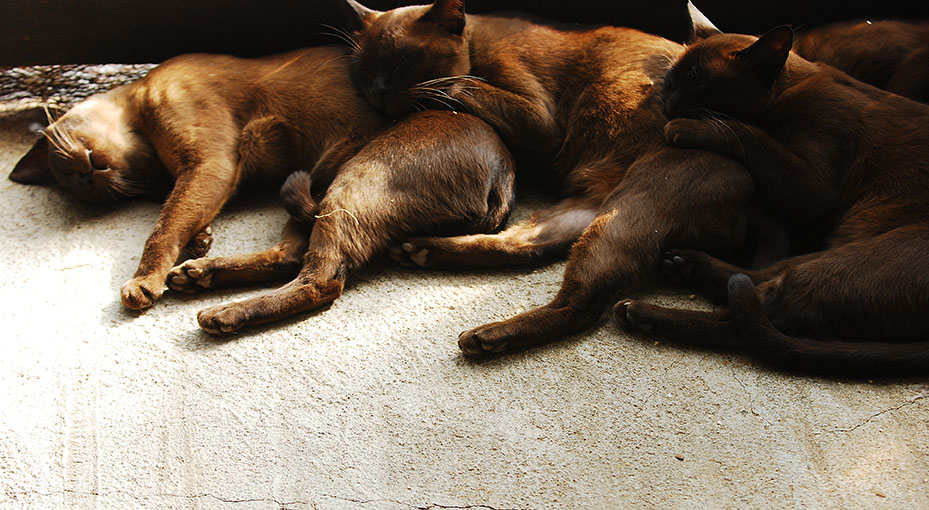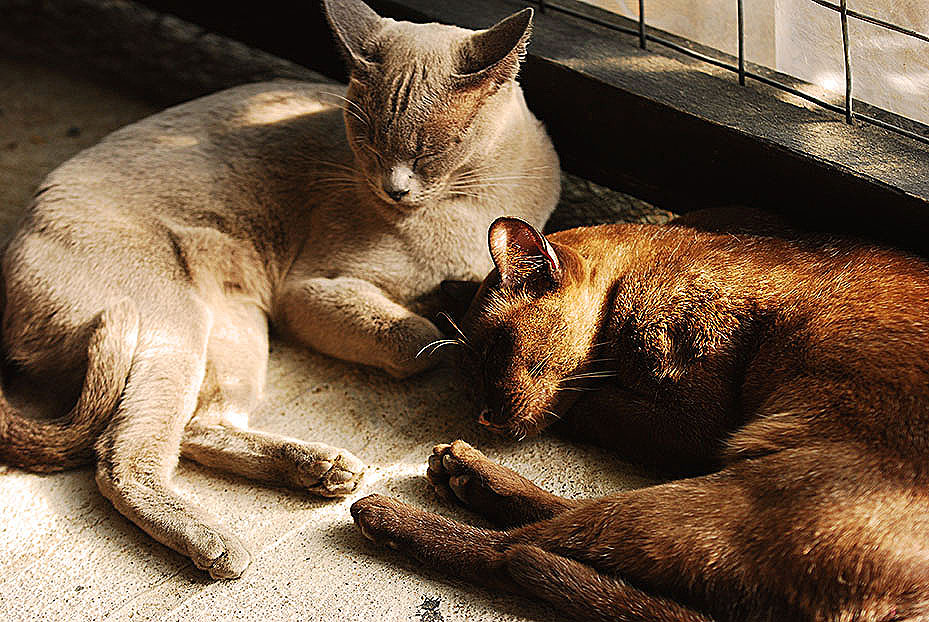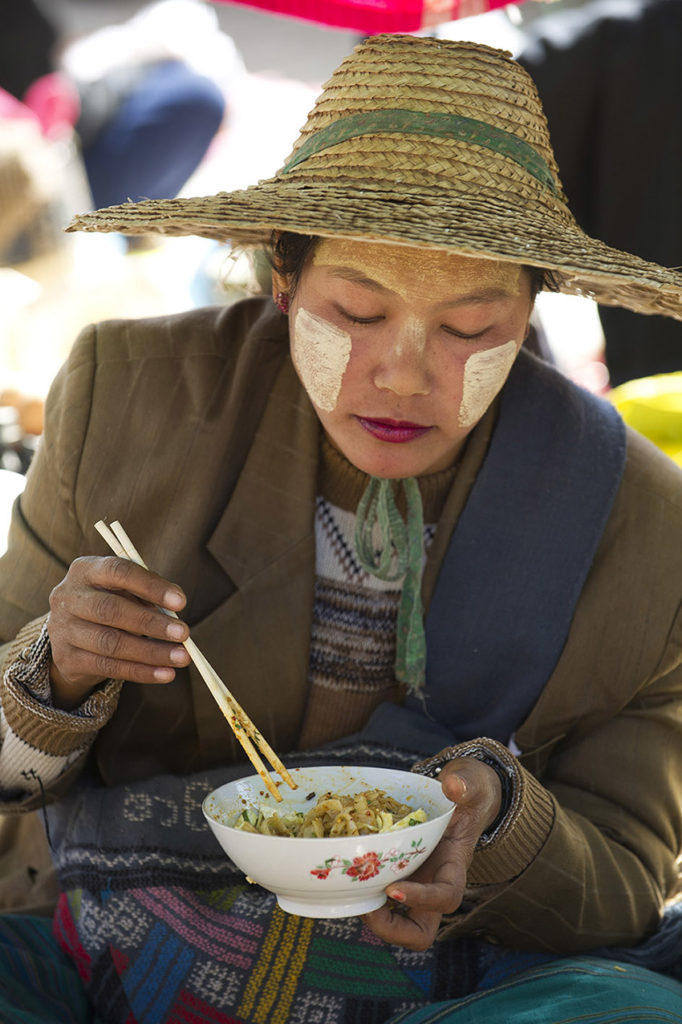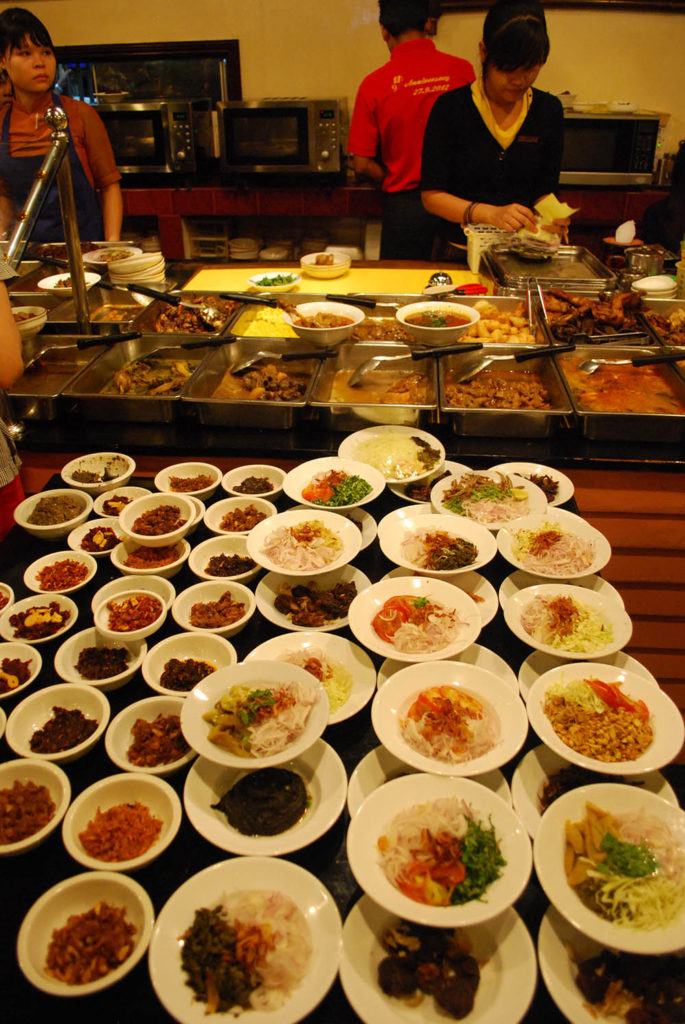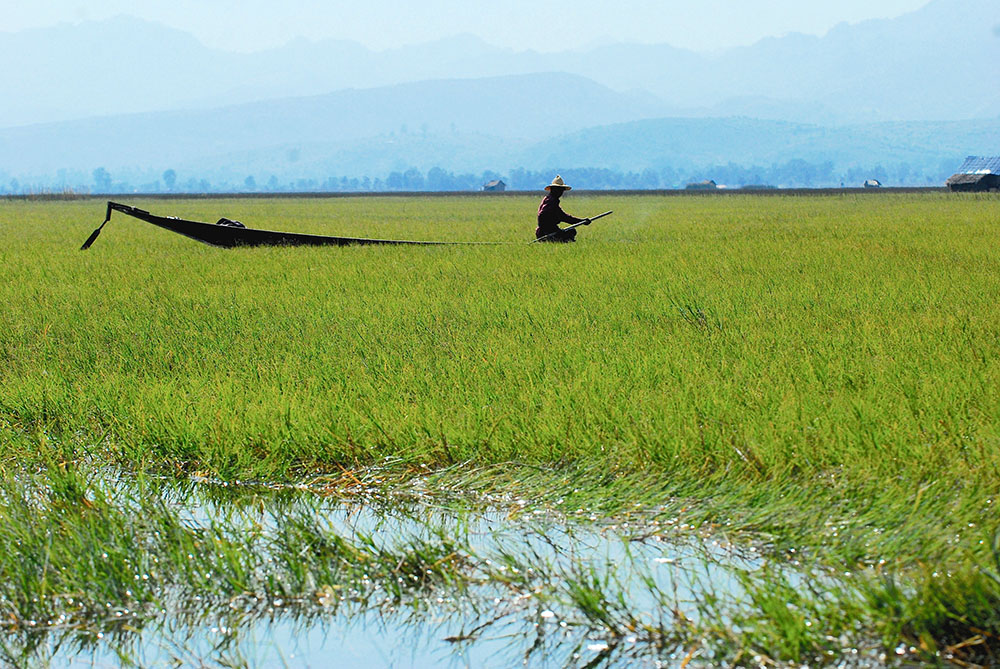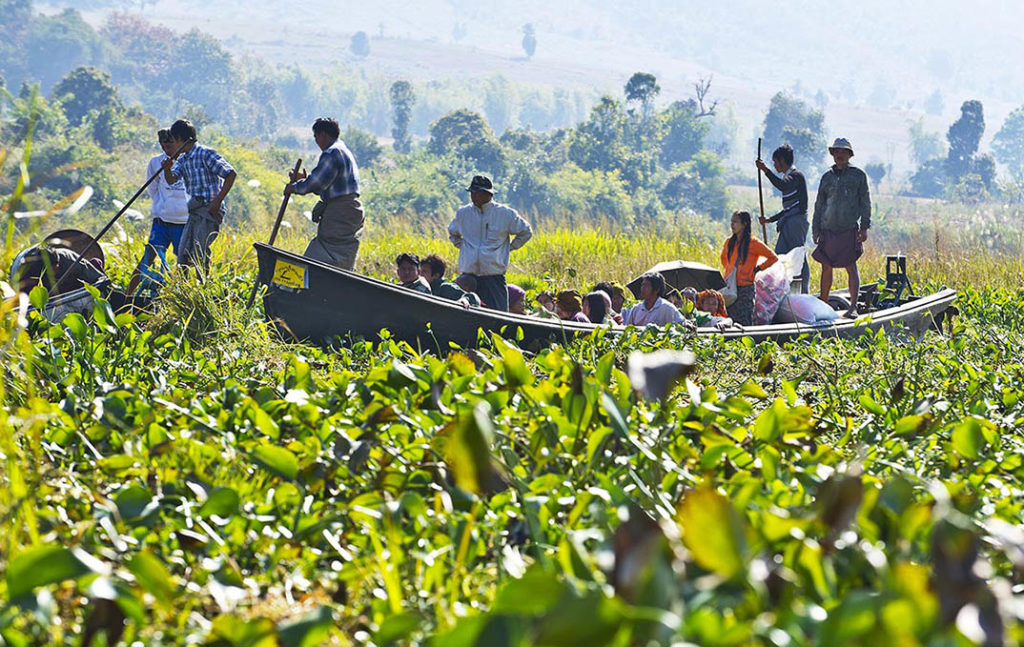In 2013 zag het leven er in Myanmar heel anders uit dan nu. Er was hoop voor de bevolking, want na jarenlange onderdrukking en een streng autonoom en militair regime, waren de grenzen open. Ook was politica Aung San Suu Kyi met haar democratische partij aan de winnende hand. Inmiddels is ze afgezet en veroordeeld voor corruptie. Door het etnische geweld tegen de Rohungya bevolking en een militaire coup in 2020, veranderde alles. Myanmar is opnieuw afgesloten van de buitenwereld en de bevolking is haar stem kwijt. Toch moeten we Myanmar niet vergeten. We eren daarom graag de mensen en diens cultuur dat destijds voelde als een warme deken. Daarom blikken we in deze Flashback terug met onze reportage.
Tekst: Angelique van Os | Fotografie: Henk Bothof
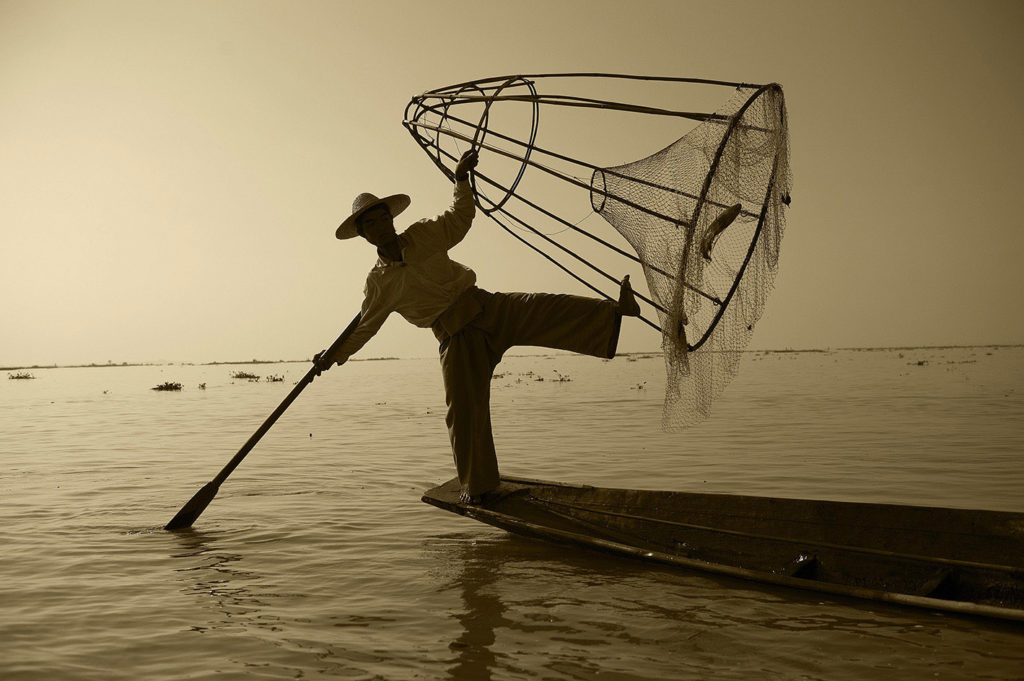
De zon staat laag aan de horizon in Myanmar, terwijl de laatste nevelresten verdampen boven het water. De eerste Intha vissers zijn in alle vroegte al op het Inle meer te vinden en tonen hun inmiddels beroemde peddeltechniek. Dit gebied ligt in het oosten van Myanmar. Sierlijk, als een ballerina balanceren ze op één been op de voorplecht van de boot, terwijl ze met het andere been rond een peddel roeien, waardoor de boot in beweging komt. Een manshoge kegelvormige fuik van bamboe vormt hun visnet. Wanneer er iets beweegt in het heldere water, zakt de fuik en wordt de vis gevangen.
Huizen op palen
Het Inle Lake staat bekend als een van authentiekste meren van Azië. Dat komt mede door de huizen op palen. Tientallen kleine, grote, eenvoudige of rijk gedecoreerde houten- en bamboehuizen op palen zien we voorbijglijden vanuit ons motorbootje. Vele beschikken over fraaie balkons met uitzicht over drijvende tuinen en het omringende berglandschap van de deelstaat Shan. Het meer ligt 900 meter boven de zeespiegel en is met haar 158km2 groot genoeg om de in hoog tempo toenemende toeristenstroom die naar Myanmar reizen te ontvangen. De toeristen komen vooral af op de drijvende markt van Ywama. Hier verhandelen kooplieden per boot hun waren. De enorme belangstelling is niet gek. Reizen naar Myanmar, voorheen Birma, is immers jaren moeilijk geweest en de authenticiteit en volkse tradities zijn veel meer intact dan in buurland Thailand.
Achtergrond Myanmar
De voormalige Engelse kolonie was tussen 1962 en 1988 volledig geïsoleerd van de buitenwereld. Hierdoor was reizen naar en in Myanmar bijna onmogelijk. Dit kwam door de dictatuur van generaal Ne Win en diens Revolutionaire Raad. Zijn totalitaire systeem en leger van spionnen hield de bevolking nauwlettend in de gaten en iedereen die hem in de weg zat werd de mond gesnoerd. Economisch raakte Birma in verval. Van 1974 tot 1981 ontstonden vele stakingen en (studenten) opstanden, waarbij in 1988 honderden doden vielen.
Een staatsgreep, vrije verkiezingen, corruptie en strijd naar onafhankelijkheid hielden het land jaren in haar greep. En het beruchte 15 jaar lange huisarrest van politica en Nobelprijswinnaar voor de Vrede, Aung San Suu Kyi, zorgde voor meer internationale afkeer. Sinds haar vrijlating in 2010 en haar oppositiepartij, de Nationale Liga voor Democratie (NLD), in 2015 de verkiezingen heeft gewonnen, lijkt het tij te keren. Met Suu Kyi als buitenlandse minister en haar vertrouweling Htin Kyaw als president, is er een voorzichtige stap richting democratie gezet.
Een Pa-O vrouw ->
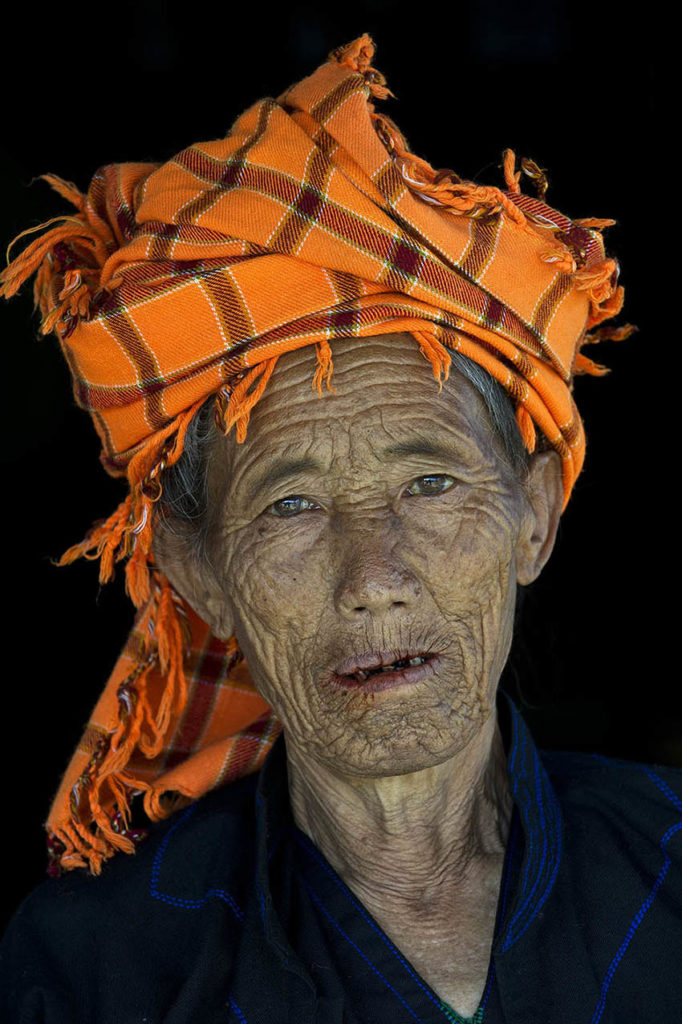
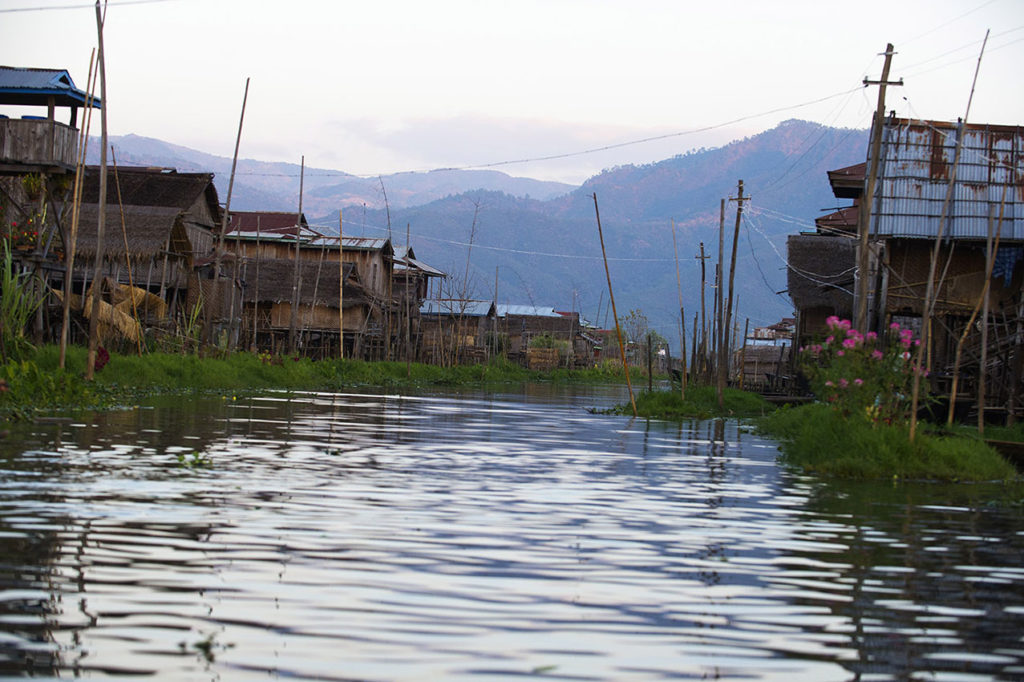
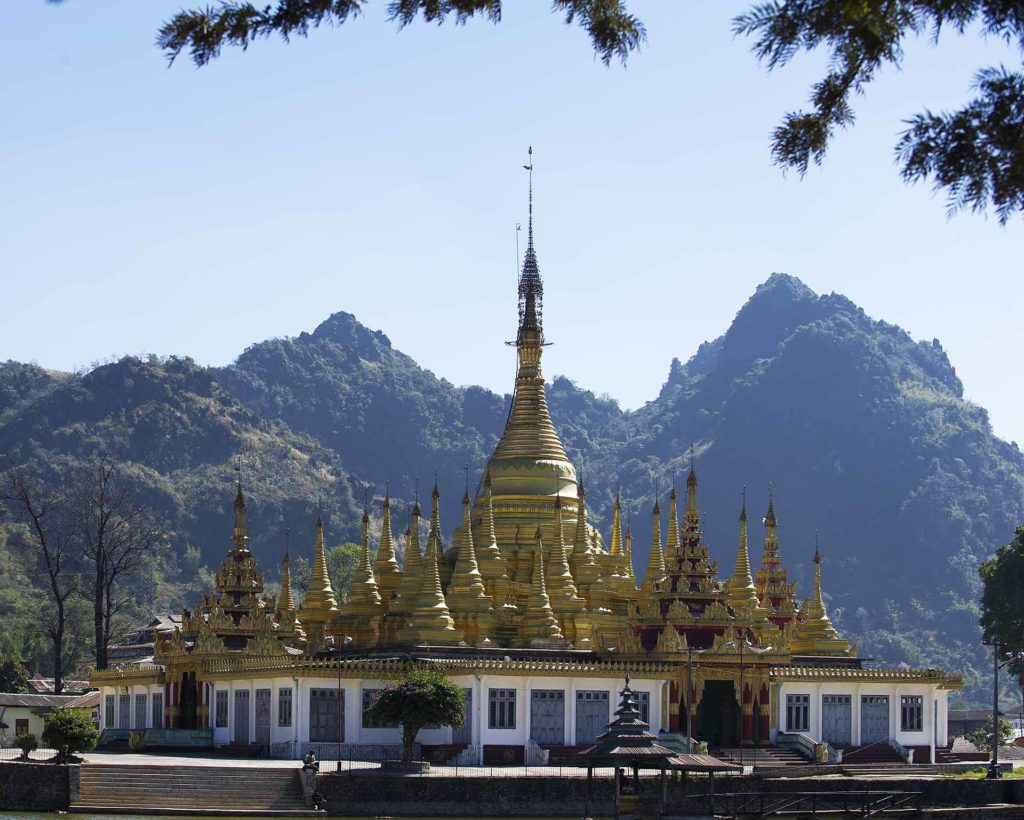
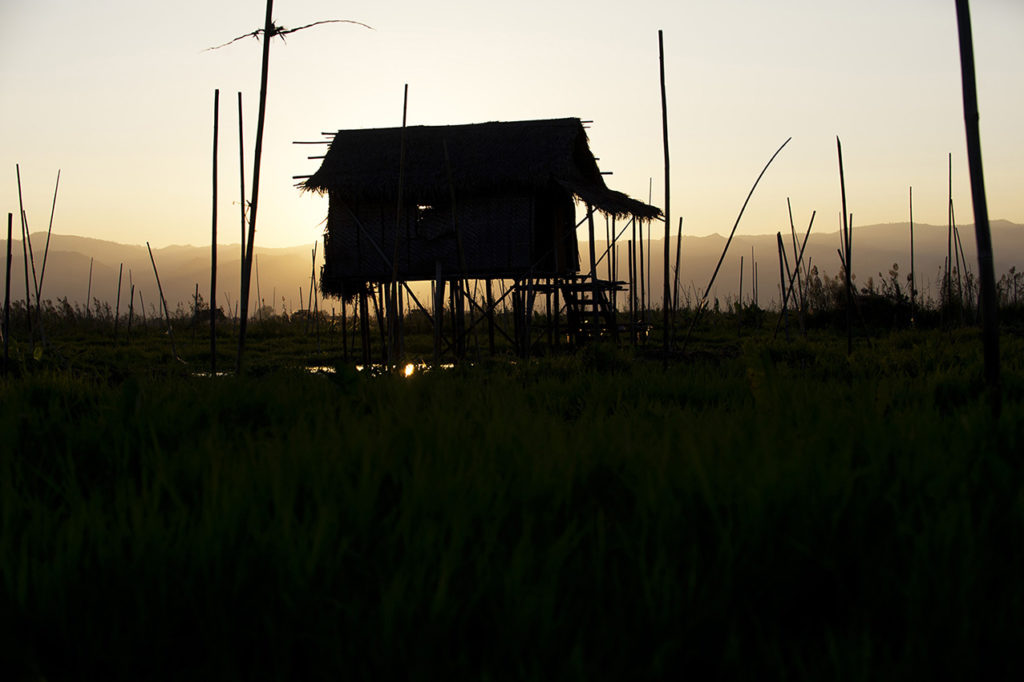
HET HUIDIGE MYANMAR
Dit artikel is geschreven voordat er sprake was van de gevoelige politieke kwestie jegens de Rohingya. In 2017 is dit geëscaleerd. De Rohungya is een islamitische minderheid die doelwit is van etnisch geweld in Myanmar. Tevens worden journalisten en mensen die zich kritisch uitten ten opzichte van het huidige regime gevangengezet of zelfs gedood. Tevens is de regering van Aung San Suu Kyi afgezet en is de politica aangeklaagd. Ze is veroordeeld tot vijf jaar gevangenisstraf. In 2020 is er door het militaire regime dat sprak van fraude bij de verkiezingen, een coupe gepleegd. Mensen werden en masse opgepakt, veroordeeld en deels vermoord. Het regime is nog steeds aan de macht en onderdrukt iedereen die in opstand komt.
Het vreedzame Myanmar wat wij aanschouwden lijkt opnieuw verleden tijd. Vanwege de politieke situatie is het onveilig om naar Myanmar te reizen. Echter willen we wel graag onze reis delen, want het is een prachtig land met een vriendelijke bevolking en dat moeten we niet vergeten. | Voor meer info kijk hier.
Heilige bouwwerken Myanmar
De liefde voor Aung San Suu Kyi is overal in Myanmar zichtbaar. op posters, op vlaggen en verbeeld in kitscherige souvenirs. Ze lijkt op handen te worden gedragen. We dalen echter verder af van de bewoonde wereld, naar het zuiden. Gouden pagodes met hun stoepa’s (een religieus complex met ronde torens) pronken aan de rand van dorpen. Geen ander Aziatisch land telt zoveel heilige bouwwerken als Myanmar. Het boeddhisme vormt de belangrijkste en meest tastbare levensfilosofie in de dagelijkse samenleving.
Wateroerwoud
Wij zijn onderweg naar Loikaw, een minder bekende stad in het oosten van Myanmar. Hiervoor moeten we het volledige meer oversteken. Het meer wordt smaller, kronkelt als een slang en verandert plots in een jungle van waterhyacinten. Opeens wordt het druk. Meerdere sloepen voor ons zitten vast met hun schroeven in de planten. De boot wiebelt wanneer een vaarder voor op de punt balanceert en probeert met een spaan zich een weg te banen door het wateroerwoud. Langzamerhand lukt het en is de weg vrij. Passerende watertaxi’s bepakt met locals kijken verbaasd en nieuwsgierig als ze ons voorbij zien drijven; ze komen hier nauwelijks toeristen tegen. Een grote glimlach verschijnt bij oogcontact en een simpele begroeting ‘mingalaba’ (hallo).
Oneindig schouwspel
De lange tocht van vijf uur verveelt geen moment. Er valt constant wat te zien. Aan de oevers struinen koeien. Boeren werken op het land en kinderen zwaaien uitbundig vanaf de kade. Daarbij verandert het waterlandschap constant: volle gewassen maken plaats voor het brede en kalere tweede meer, Samkar. Diamanten schitteren op het water door het felle zonlicht, gevolgd door een deken van laag gras. Het is een oneindig schouwspel, waarbij het constante gebrom van de motor en de stilte van de omgeving rustgevend werken. Meditatief bijna. Om hier te reizen is toestemming nodig van de Pa-O, een van Myanmar’s 135 etnische volken. Deze vriendelijke mensen spreken hun eigen taal en de vrouwen zijn herkenbaar aan hun zwarte kleding met gekleurde randjes en fel oranje hoofddoeken.
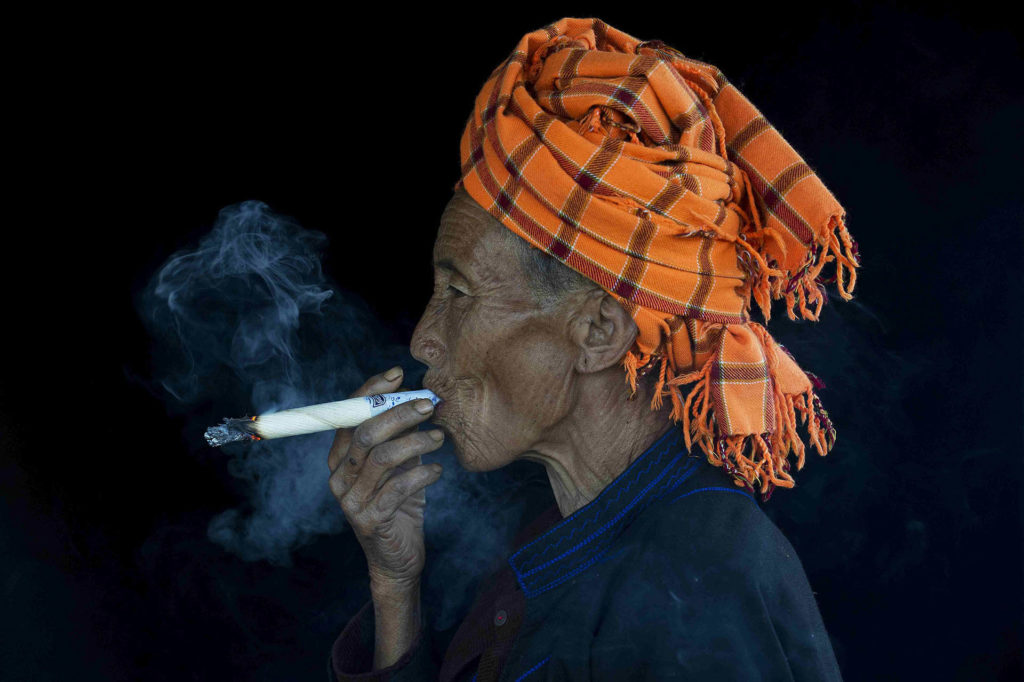
Op naar Loikaw
Na het derde kleinere meer, Hpekhon, vervolgt de tocht per busje. We rijden dwars over hobbelige wegen langs vele dorpjes. Het Shan-gebied gaat over in de Kayah staat. Sinds 2005 is het mogelijk om hier te reizen, weliswaar met een goedgekeurde permit. Onderweg wisselen rijst- en korenvelden elkaar af, gevolgd door heuvelachtige rode kleivlakten. Na een strenge controlepost te hebben gepasseerd, doemt hoofdstad Loikaw op in de verte.
Grote happening
In Loikaw is het een drukte van jewelste. De straten zien zwart van de scooters en brommers vanwege de jaarlijkse viering van de Kayah staat. Dit vindt begin januari plaats. Het is een grote happening voor de lokale bevolking. Het festival bestaat uit een imposante kermisachtige markt vol spotgoedkope spullen uit China. De tientallen stands vormen een bont kleurenpalet. Schoenen, kleding, traditionele longy’s (omslagrokken voor zowel mannen als vrouwen), speelgoed, tassen, accessoires, fruit en snacks; er is van alles te vinden. Mensen onderhandelen, jongelui dwalen vrolijk dronken rond en stoere mannen laten zich ter plekke tatoeëren.
Giraffevrouwen van Myanmar
’s Avonds zijn er op een groot podium diverse traditionele dansoptredens van etnische stammen uit het hele land. Vanuit grote smoezelige boxen galmen oosterse klanken over het imposante grasveld dat gevuld is met geruisloos toekijkend publiek. Voor westerse begrippen zijn de dansen niet boeiend, in tegenstelling tot de vertederende warmte die de mensen aan elkaar tonen. Wanneer de zachtaardige Padaung vrouwen ons zien, zwaaien ze enthousiast. We hebben ze ’s middags opgezocht in het dorpje Sunboon, waar slechts tien traditionele longnecks ofwel giraffevrouwen wonen.
Zware nekringen
De ‘giraffecvrouwen’ heten eigenlijk Padaung vrouwen zijn bekend vanwege hun lange zware nekringen, die ze overigens ook aan beide benen onder de knie dragen. De omgeving van Loikaw is hun oorspronkelijke leefgebied, en niet zoals veelal gedacht wordt het noorden van Thailand. Veel vrouwen zijn tijdens politieke onrust en armoede in de omgeving gevlucht naar het buurland. Daar dragen ze voornamelijk traditionele sierraden om geld te verdienen met poseren voor toeristen.
Traditionele leefwijze Padaung vrouwen
In deze regio leven de laatste Paudaung vrouwen nog volgens authentieke, traditionele leefwijze. Je moet echt naar ze op zoek gaan of een goede gids hebben, zoals wij. Eén voor één kwamen ze aanwaaien, met hun vrolijk gekleurde haartooien en manden vol handgeweven sjaaltjes op de rug. Ze maakten zich net klaar voor het festival. Er zijn nog slechts nog zo’n twintig traditionele Padaung vrouwen in dit gebied. Tien ervan leven in het dorpje Sunboon en zijn tussen de 44 en 60 jaar oud.
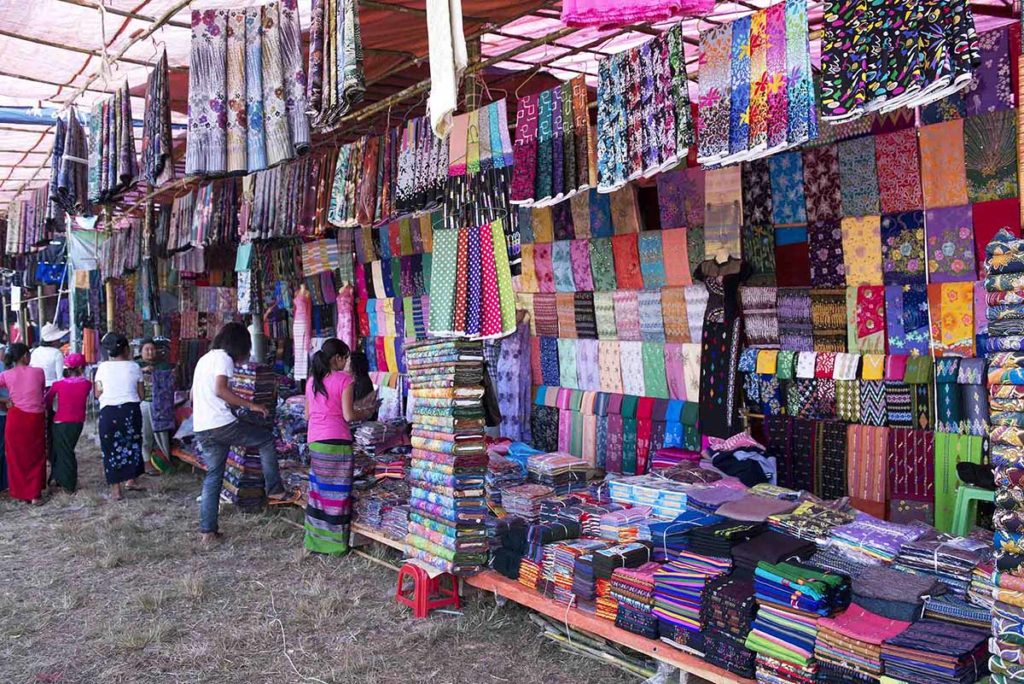
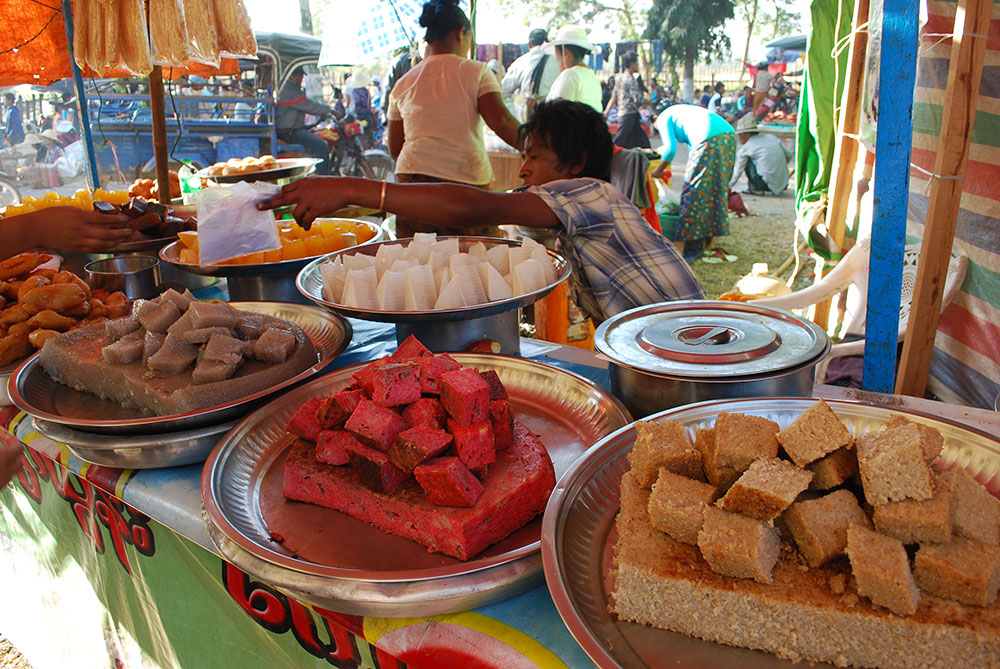
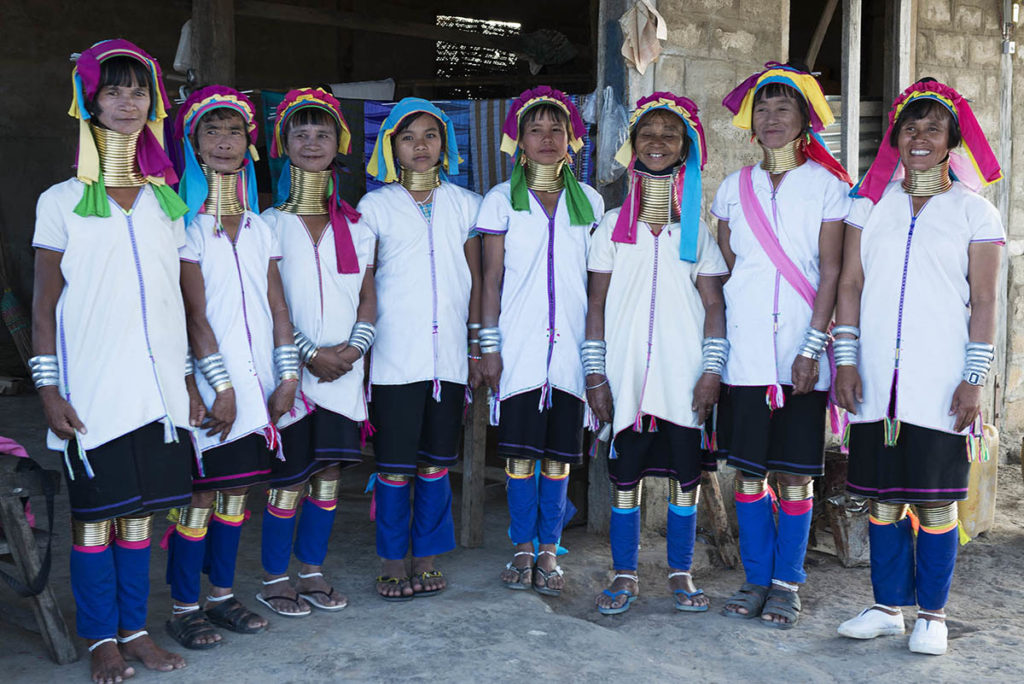
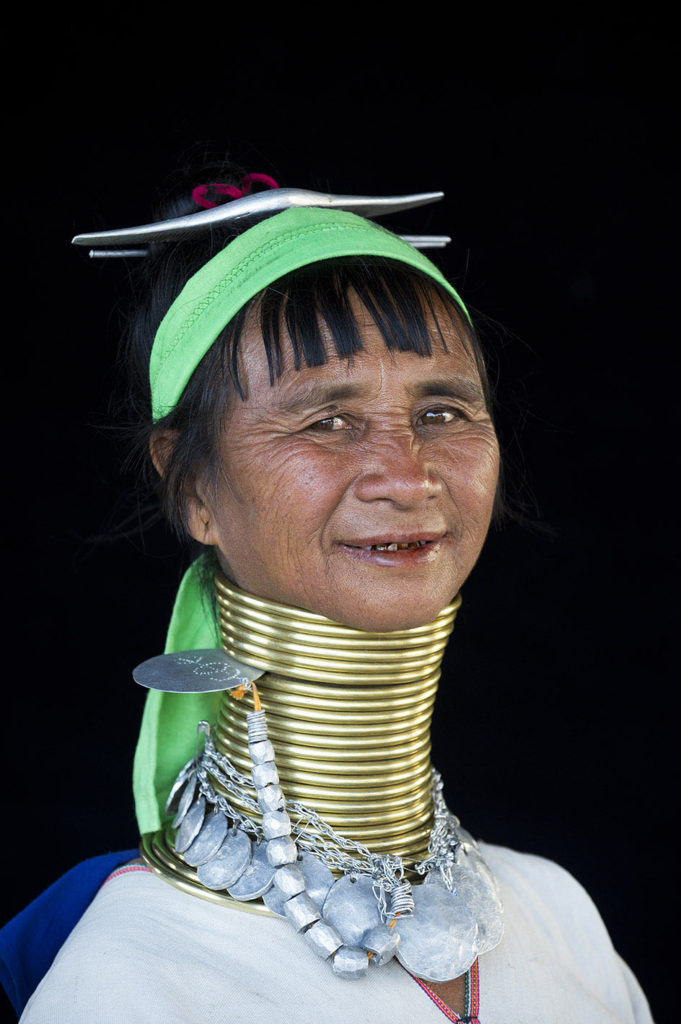
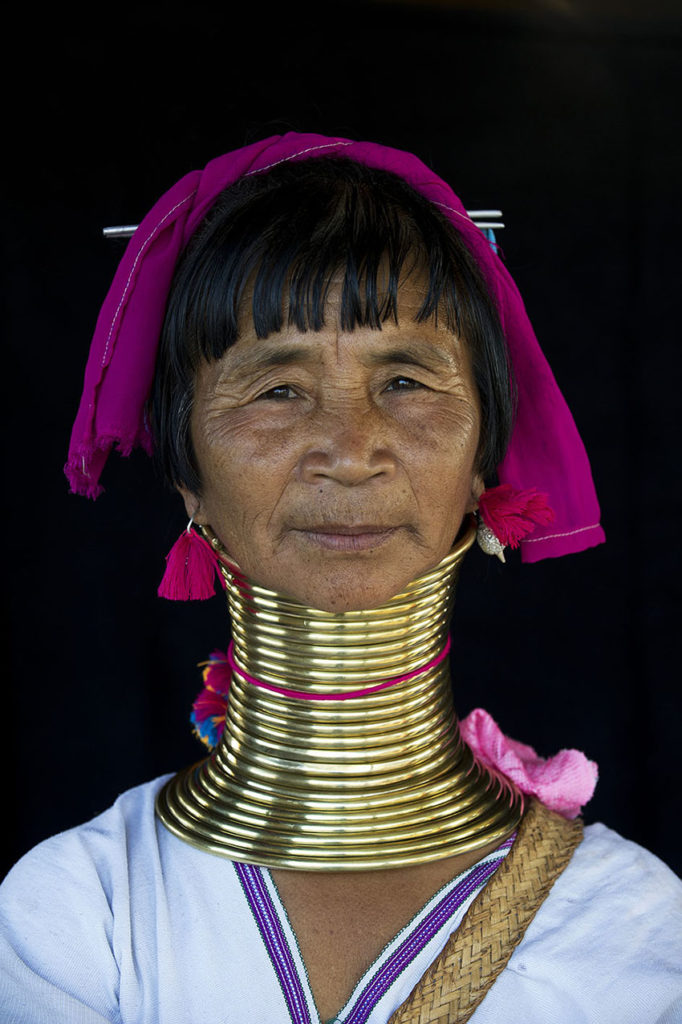
Verdwijnende cultuur
Wat vinden de Padaung ervan dat hun gebruiken langzamerhand verdwijnen? “Heel jammer. Het is onze cultuur, ons erfgoed. Toch begrijp ik het wel, want het is best zwaar. Sommige vrouwen kunnen zich moeilijk bewegen of hebben moeite met slikken”, tolkt onze gids. “Ik kreeg mijn eerste ring toen ik vijf jaar was. Ik ben nu zestig en heb in al die jaren nog nooit de ringen afgedaan. Dit hoort bij mij”, zegt de oudste vrouw liefdevol. De ringen kunnen tot vijf kilo wegen. Ze rekken de nek niet op – zoals veelal gedacht wordt-, maar drukken de schouders naar beneden. Het is optisch bedrog. Elk jaar komt er een ring bij, tot maximaal 20 à 25 ringen. Hierbij zijn de onderste breder sluiten aan op het sleutelbeen.
Ringen symbool voor identiteit en schoonheid
Waarom vrouwen de ringen dragen is wat onduidelijk. Een veelvoorkomende historische verklaring is de bescherming tegen tijgerbeten. De vrouwen geven zelf aan dat de ringen symbool staan voor hun identiteit en schoonheid. Een mevrouw draagt bijzonder gedetailleerde oorbellen. “Die zijn van mijn overgrootmoeder geweest. Het is mijn kostbaarste bezit”, zegt ze met een grote glimlach.
“Ik kreeg mijn eerste ring toen vijf was. Ik ben nu zestig en heb in al die jaren nog nooit de ringen afgedaan. Dit hoort bij mij.”
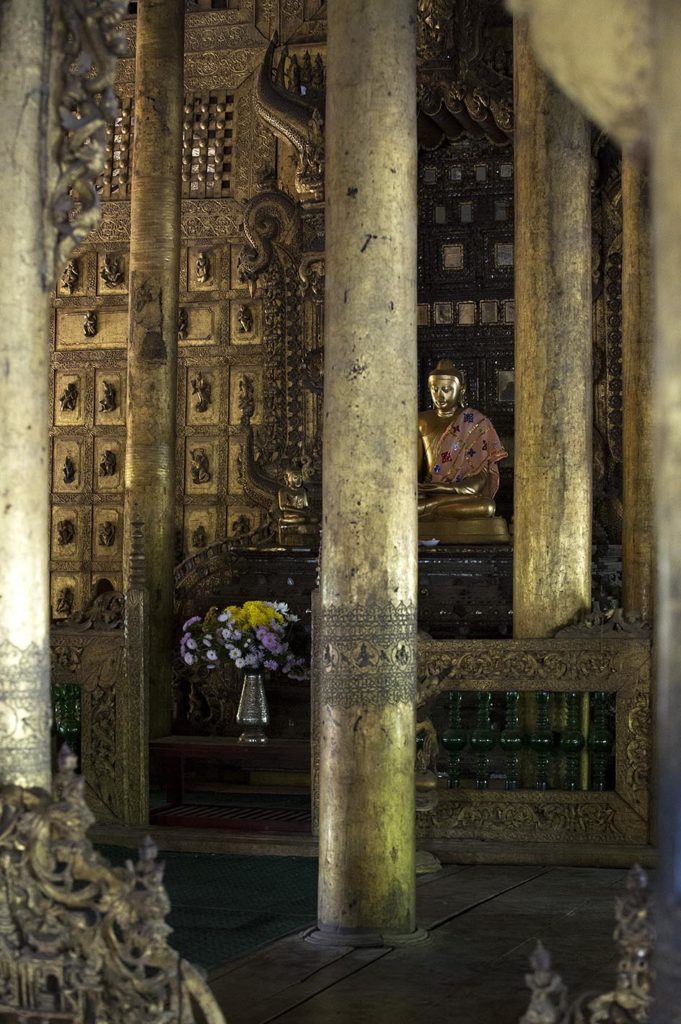

Toename toerisme Myanmar
De Padaung zijn niet de enige minderheidsgroepen die steeds meer verdwijnen, dat geldt ook voor de Kayah. Zij dragen alleen traditionele kleding tijdens bijzondere ceremonies of feesten. Tijden veranderen; het absorberen van westerse culturen en het streven naar economische vooruitgang kan het einde betekenen van eeuwenoude volken en hun culturen.
De snelle toename van het toerisme is voor het land een enorme verandering. Volgens onze vier lokale gidsen is er vanaf 2011 een toename van 50 procent in reizen naar Myanmar! Deze kenners zijn het er over eens dat toerisme zeer goed is voor de economie, want het zorgt immers voor meer werkgelegenheid. Maar de infrastructuur kan de vraag nauwelijks aan. Daarnaast hopen ze allerminst op een tweede Thailand, waar de cultuur door het massatoerisme haar authenticiteit steeds meer verliest.
Poppenkast klooster Mahagandayon
In een voorstadje van Mandalay, Amarapura, zien we de poppenkast rondom het grote klooster Mahagandayon waar tien jaar geleden nauwelijks toeristen kwamen. Nu zijn er bijna meer bezoekers dan monniken. Toeristen dringen zich op wanneer gelovigen in de rij wachten voor hun eten en gaan soms respectloos als paparazzi te werk. Wat vinden de monniken hier van? “We stellen ons open voor bezoekers; zijn nieuwsgierig naar hun achtergronden en tonen graag hoe we hier leven. Alleen zitten we hier niet op massatoerisme te wachten, en dat zie je hier inmiddels wel”, zegt Ashim Kelasa, meditatief mentor van het klooster.
Weinig privacy
Ashim vertelt dat er verder weinig privacy en rust is. Bezoekers tonen soms te weinig respect en zijn te veel aanwezig tijdens gebeden of het diner. “Het is zeer wenselijk dat dit in de toekomst veranderd. Spreiding of beperkte toelating van bezoekers is een gepaste oplossing.”
Triest circus Amarapura
Het circus van Amarapura is triest en staat niet op zichzelf. Ook het klooster van de Springende Kat bij het Inle meer is veranderd in een toeristenattractie. Hier sprongen katten door hoepels, maar door de toestroom zijn de dieren te moe. Eén van de gidsen vertelt dat de monniken tegengas geven, maar sommige touroperators dubbele belangen hebben en druk op hen uitoefenen.
De omschrijving in de voorgaande alinea’s hiernaast over de toename van het toerisme, zijn zonder twijfel nu niet meer van toepassing in het huidige Myanmar. Het is mogelijk een van de weinige positieve ontwikkelingen van de afgelopen jaren, dat het kortstondige massatoerisme dat snel op gang kwam, volledig gestagneerd is door de politieke ontwikkelingen.
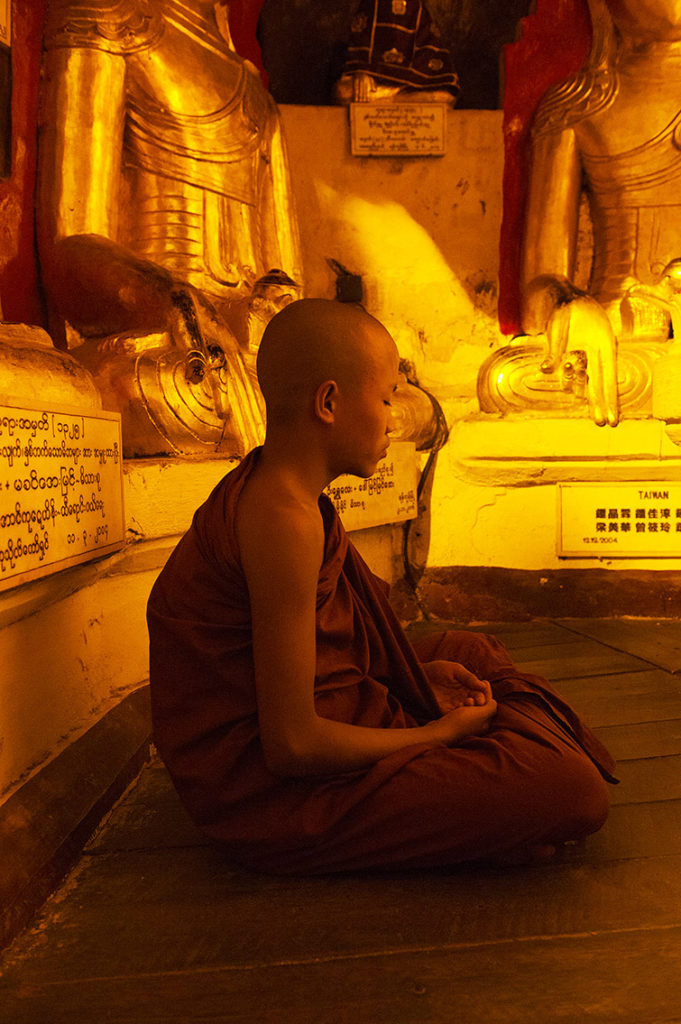
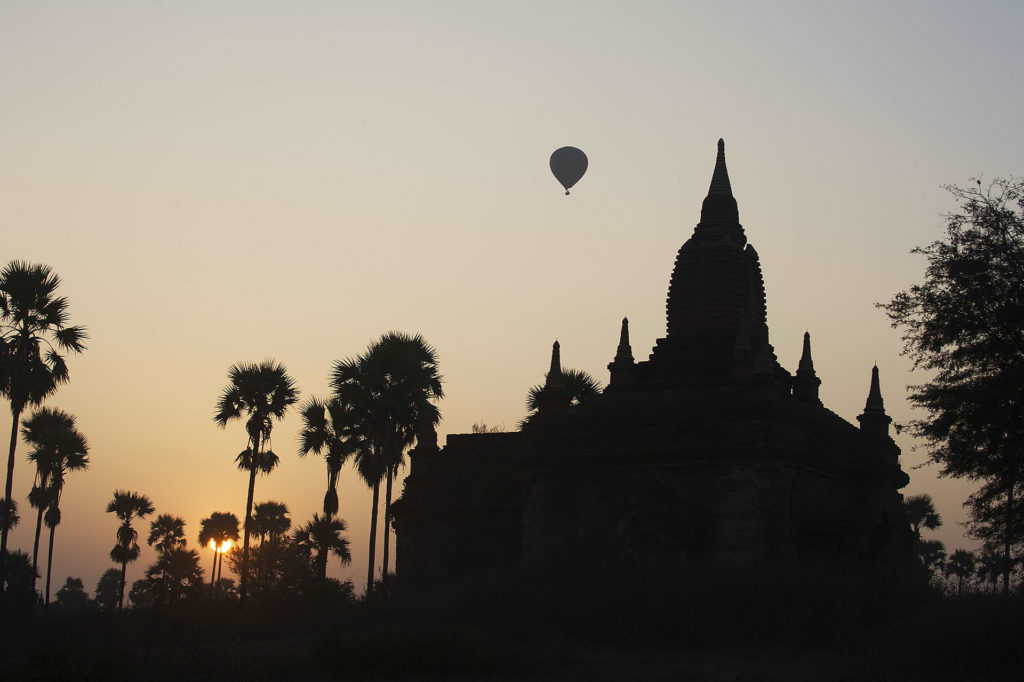
Zonsondergang, Bagan.
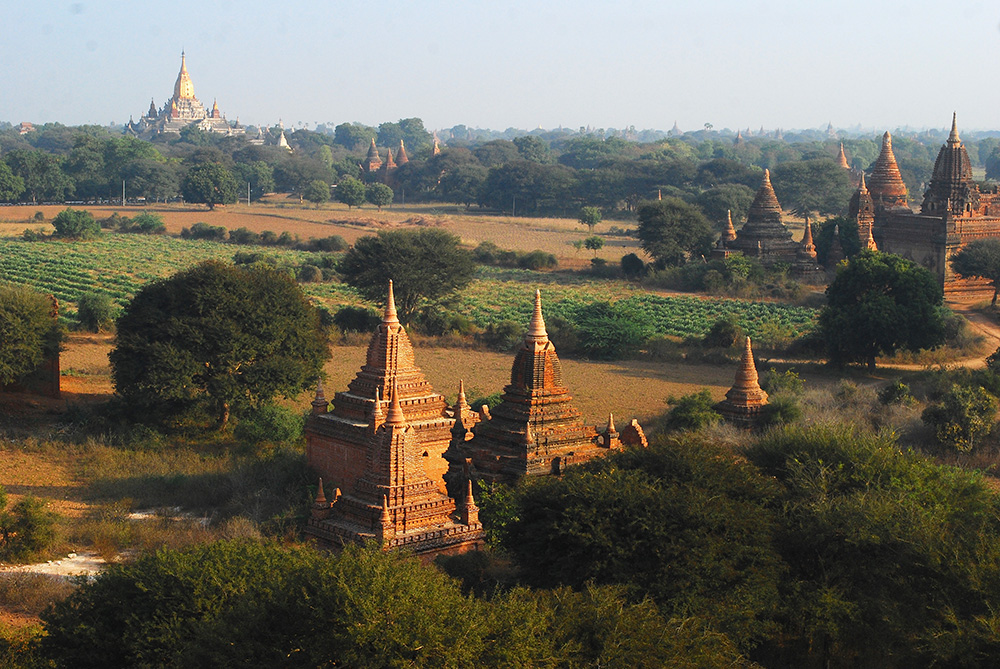
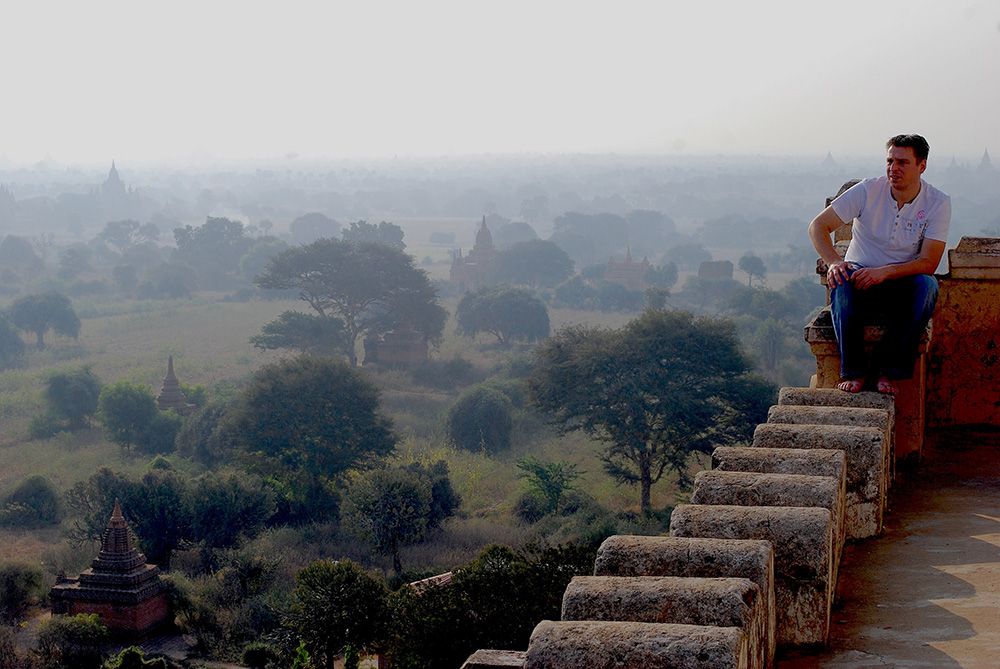
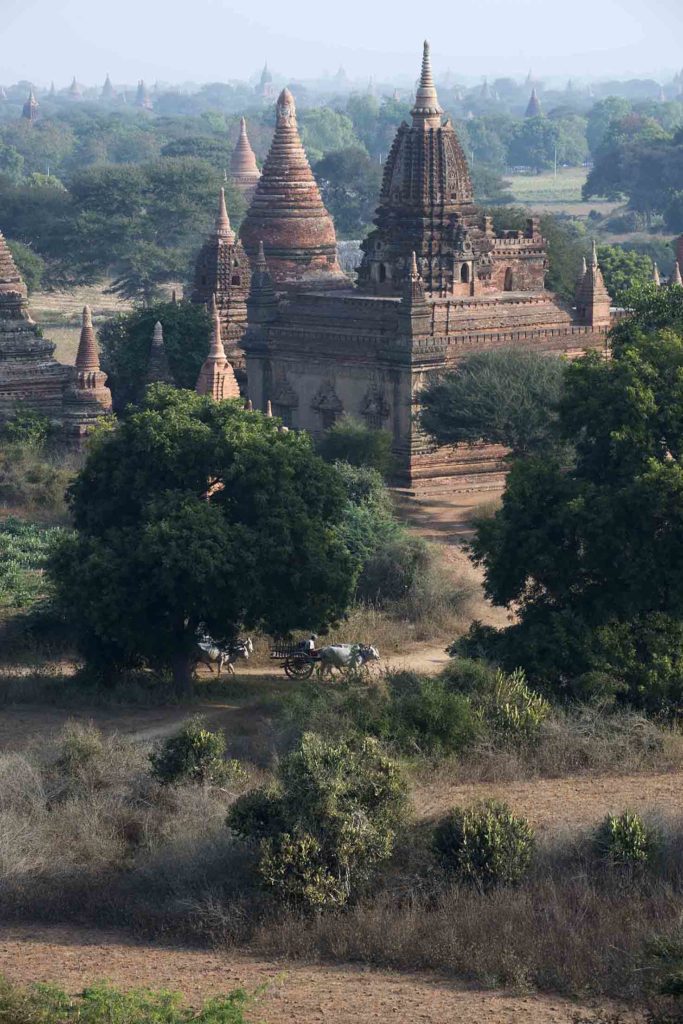
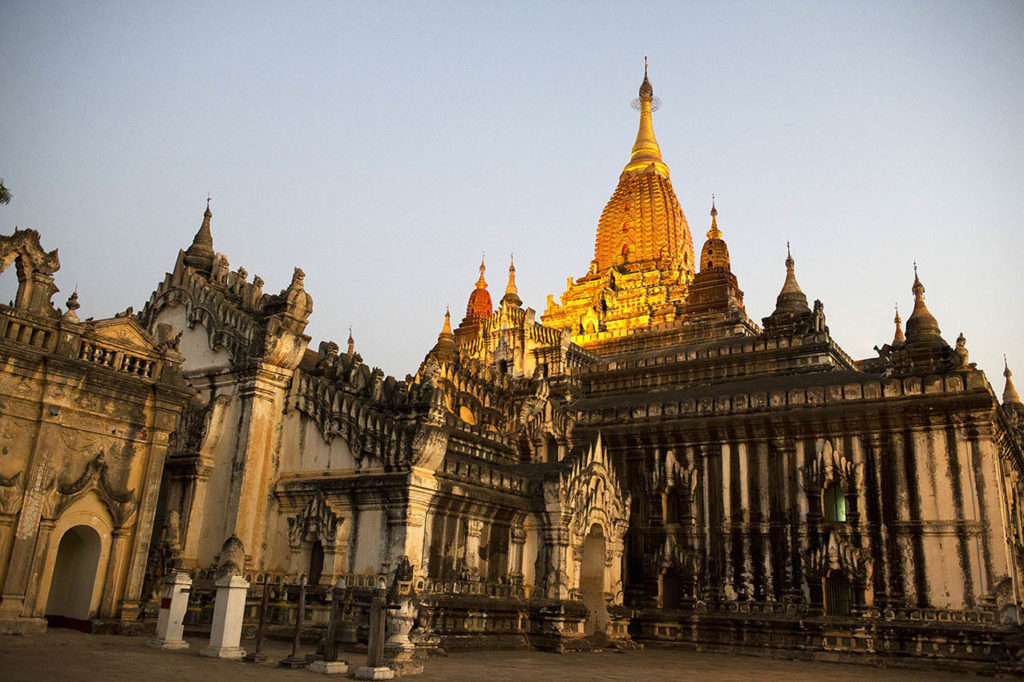
Bagan
We verruilen het nog onontdekte Loikaw voor de populaire bestemming Bagan, stad van tempels, pagoden en stoepa’s. Omdat dit gebied zo groot is als de provincie Utrecht, valt de drukte met de juiste timing goed te ontlopen. Gids Ko Naing Lin weet dan ook precies waar hij moet starten.
Shwesandaw pagode
Rond kwart over acht ’s ochtends is er geen kip te bekennen bij de Shwesandaw pagode. “Tegen zonsondergang ziet het hier zwart van de mensen die reizen door Myanmar”, roept Lin terwijl we peentjes zweten om boven te komen. De grote ongelijke treden vragen alle concentratie. De pagode is één van de 2200 nog intacte bouwwerken en dateert uit 1057, de bloeiperiode van koning Anawratha. Shwesandaw is een van de weinige monumenten die nog beklommen mag worden. De meeste bouwwerken verkeren in een te slechte staat of zijn beschermd. Het uitzicht op het bovenste vierkante terras is werkelijk adembenemend. Tot zover het oog reikt staan alleen maar pagodes en tempels aan de hemel. Ze vormen een mystiek stilleven, dat ontwaakt onder een deken van nevel.
Gouden bakstenen en witte stoepa puntjes pronken aan de hemel, waar je ook kijkt. De een is sober en slecht gerenoveerd, de ander juist mooi intact en fraai versierd. Dat laatste geldt bijvoorbeeld voor de Gubyaukgyi Tempel (in Wetkyi). In de tempel vind je Boeddha fresco’s uit de 13e eeuw.
Koning Anawrahta
Bagan beslaat in totaal zo’n 4400 heiligdommen, die zich grotendeels bevinden in oud-Bagan. Gedurende de Birmese ‘Gouden Eeuw’, van 1100 tot 1300, was Bagan de hoofdstad van het eerste Birmaanse Koninkrijk. Daardoor schoten de bouwwerken als paddenstoelen uit de grond. “Dit komt door de bekering van het theravada-boeddhisme door koning Anawrahta (1044-1077).” Vertelt gids Lin. “De monnik Shin Arahan overtuigde de vorst dat hij nooit een goed boeddhist zou worden als hij niet beschikte over de Tripitaka, het Heilige Schrift. Die had koning Manuha van het westelijke koninkrijk Thaton in zijn bezit en wilde dit niet afstaan. Gevolg: een veldslag die Anawrahta won, waarbij hij de inwoners – inclusief de koninklijke familie- van Thaton als slaaf inzette voor de bouw van een legio heiligdommen. Dit eerbetoon aan Boeddha hielden zijn opvolgers twee eeuwen lang in stand.”
Fietsend door Bagan
We kunnen helaas slechts één dag in Bagan blijven en zijn toe aan wat beweging. We huren een fiets, wat een eitje moet zijn, want alle wegen zijn vlak. Lin trekt zijn wenkbrauw op en heeft een binnenpretje. Na een kleine tien minuten begrijpen we zijn reactie: het valt vies tegen, want de simpele stadsfietsen kunnen het mulle zand nauwelijks aan. Door Myanmar reizen met de fiets is niet eenvoudig! Al snel staat het zweet op het voorhoofd. Jaloers kijken we naar relaxt ogende stelletjes die met paard en wagen voorbij komen, maar dit is natuurlijk veel sportiever. Niet zeuren, doortrappen!
Ananda tempelcomplex
We gaan volledig op in het dun bevolkte surrealistische landschap, want de ene tempel is van dichtbij nog intrigerender dan de ander. Hoogtepunt is het beroemde witte vierkante Ananda tempelcomplex uit de vroege periode (1091). Wederom hebben we het rijk voor ons alleen. Aan het einde van de middag is het bijna verlaten stil. Dit is niet zomaar een tempel, want de muren zijn ruim tien meter hoog. En bij vier nissen staan even grote metershoge gouden Boeddha’s. “Dit is de originele Boeddha, uit de 11e eeuw. De andere drie zijn later vervangen”, fluistert gids Lin alsof hij een groot geheim verklapt. Vervolgens zegt hij: “Kijk naar het gezicht en loop nu paar passen terug. Wat valt je op?” Achteruit lopend, zien we plotseling een grote glimlach op het gezicht verschijnen. Bijzonder en een knap architectonisch grapje.
Ook nu is dat het gevoel wat overheerst, overal die oprechte glimlachen en twinkelende ogen. Bijzonder, een natie dat zoveel leed heeft moeten doorstaan en dan toch zo hartelijk en magisch is gebleven. Die hartelijkheid kun je waar je in Myanmar dan ook bent alleen maar koesteren en omhelzen, met duizend armen. ![]()
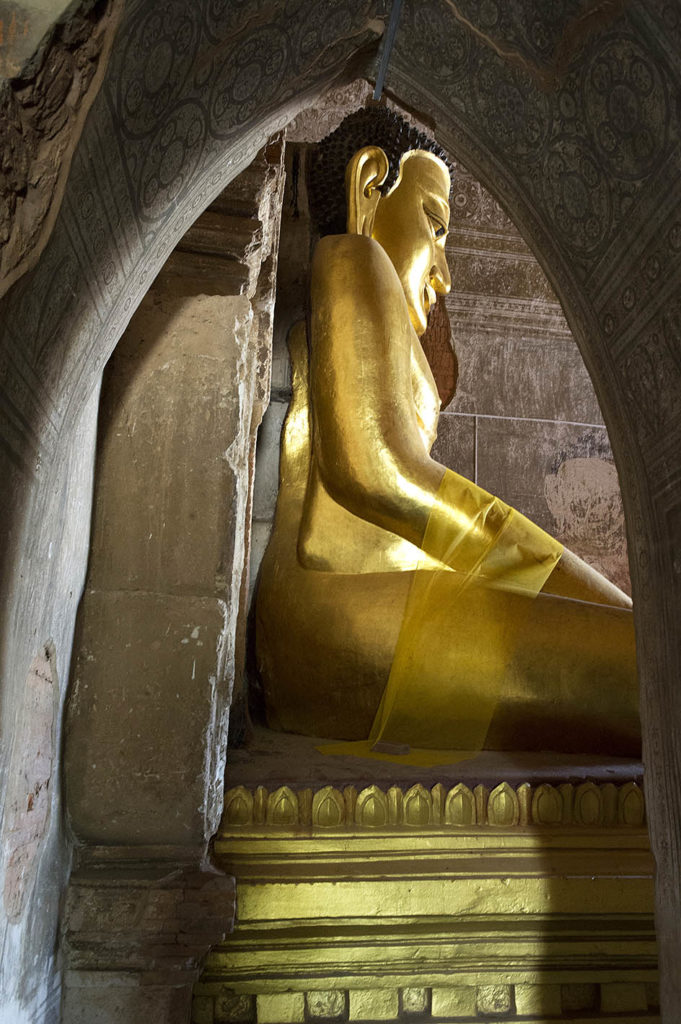
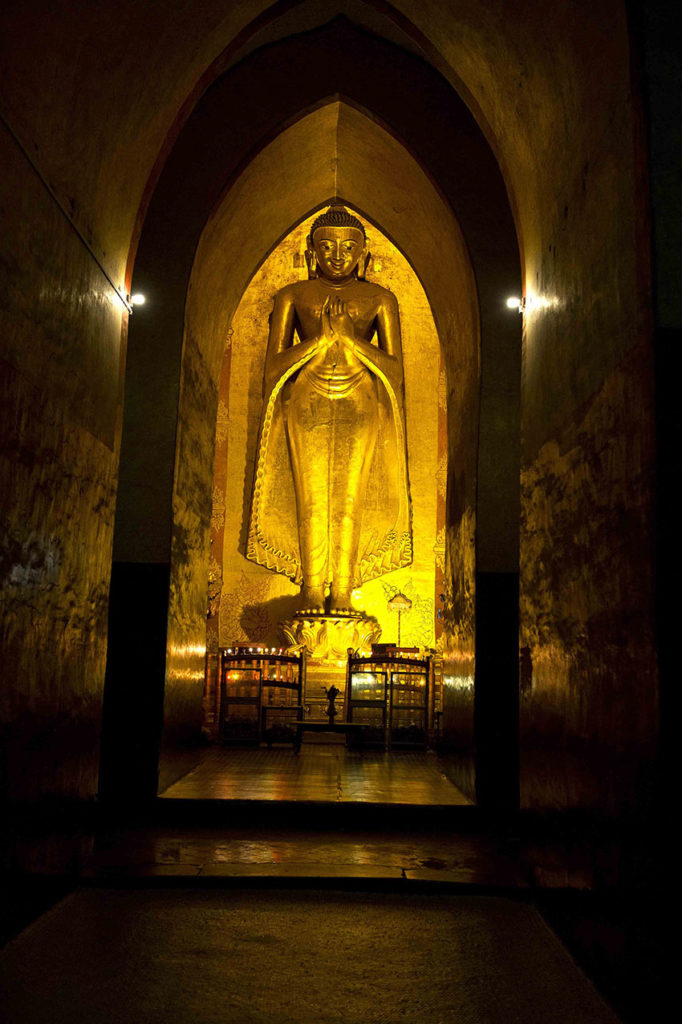
Erheen
Bijzondere reizen- & Azië specialist Dim Sum, is een van de vele aanbieders van Myanmar reizen. Deze organisatie is al jaren actief in het land en werkt uitsluitend met ervaren lokale gidsen van partner Interconnection Travels. Alles is strak en goed georganiseerd. Dim Sum verzorgt naast individuele en groepsreizen maatwerk en boekt veilige binnenlandse vluchten. Naast highlighs richt Dim Sum zich ook op off road bezoeken aan bergvolken, minder bekende steden en natuurgebieden, zoals beschreven in het verhaal. www.dim-sum.nl | 030 23 00 847
Vervoer & geld
Direct naar Myanmar reizen met het vliegtuig kan via Brussel, maar is prijzig. Diverse airlines maken een tussenstop in Singapore of Bangkok.| Reistijd: 13 à 15 uur| Kosten ticket: €900 à €1200.|Lokaal reizen met openbaar vervoer is goedkoop, maar tijdrovend en oncomfortabel. | Op vliegvelden of in grote steden kunnen dollars (nieuwe biljetten) en in toenemende mate euro’s omgewisseld worden voor de lokale kyat.| Beste reistijd: dec-mrt.
Verblijf
Onze favoriete hotels van Dim Sum’s selectie: het Bagan Princess Hotel heeft smaakvolle ruime kamers in koloniale stijl, met zwembad en jacuzzi. Het Inle Resort is een grootschalig luxe-verblijf met koloniale villa’s aan het Inle meer. Extra: uiteenlopende spabehandelingen; minpuntje: het massale en dure restaurant. Ontbijt is top. Hotel Queen Mandalay biedt ruime nette kamers in hartje stad.
Eten Myanmar
Canal Mandalay Restaurant Prachtige tuin en verbluffend traditioneel lekker eten.| 22nd Road, Btn 63th-64th Str., Mandalay
Aye-Myit- Tar Hier proef je de Myanmar cuisine zoals bij de locals thuis.|81st, Btn 29th-30th str. Nr. 371, Mandalay
Phore Kawr Kay Restaurant, Loikaw Heerlijke noedels, soepen en groenten voor een prikkie.
Feel Myanmar Food No. 124 Pyihtaungsu Avenue Str, Dagon, Yangon | feelrestaurant.com . Een geliefd restaurant onder gidsen vanwege de diversiteit en de vermakelijke hectiek in de keuken.
Inthar Heritage House
Bij het koloniale hotel en (lunch)restaurant Inthar Heritage House is niet alleen een heerlijk verblijf, het is ook een opvanghuis van tientallen Birmese katten. Het sierlijke ras was bijna uitgestorven, maar is door China Exploration & Research Society nieuw leven ingeblazen. De beesten hebben hier een eigen ‘speelkamer, slaapvertrek en speeltuin’. Het hotel is omringd door prachtige planten en bloemen, er is een fraaie shop waar lokale cadeautartikelen te koop zijn en kunst te zien is. Tevens ondersteunt het Inthar diverse educatieve projecten. Zeker een must voor kattenliefhebbers! |Inpawkhon Village, Inle meer.
